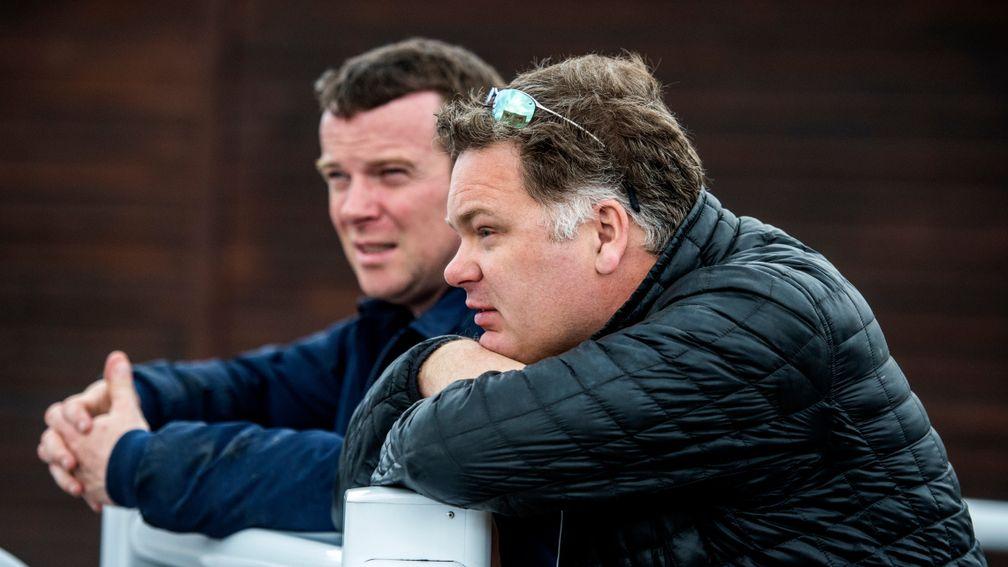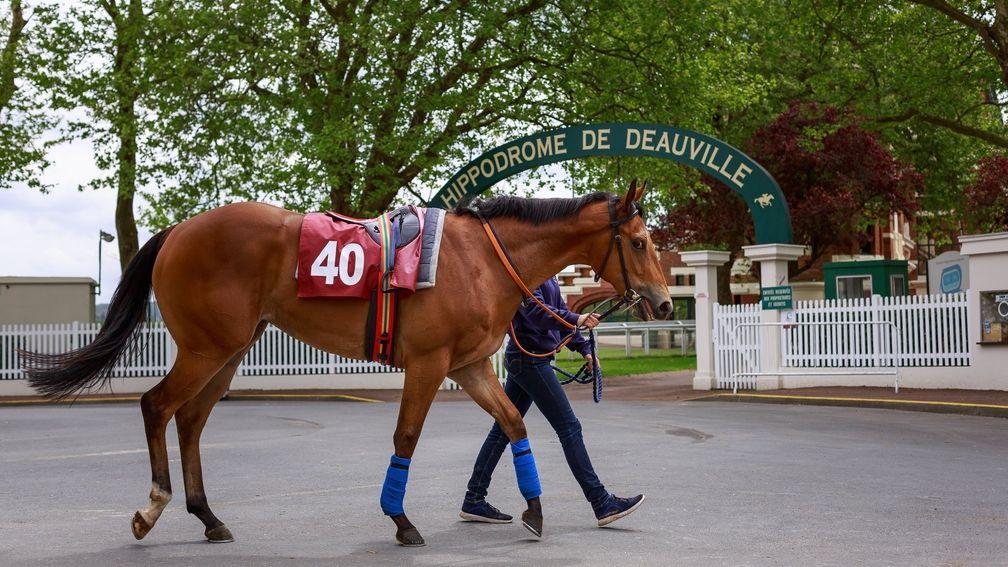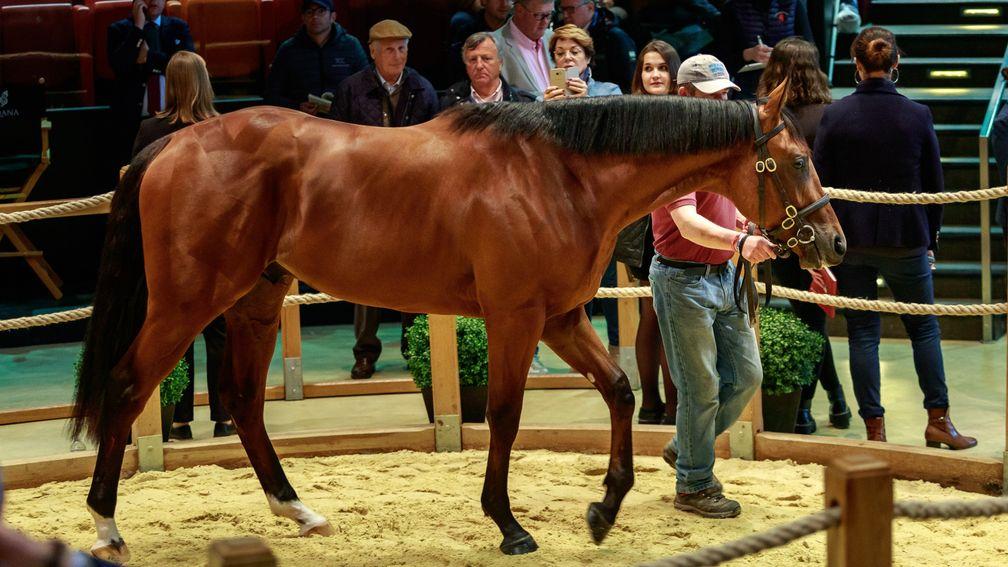Star Bloodstock's Matt Eves gives a vendor's perspective on the breeze-up season
Bragging rights for Europe's premier sale among the topics dissected

As each year comes and goes the feeling at the end of the breeze-up season varies, and the latest round of sales felt like a year of consolidation. There were highs and lows for all consignors, but there were many more happy faces around the sales grounds as, with consideration to their costs to get to the sale, many consignors look to have made a profit and will be looking to next year with a few of the debts of 2018 cleared.
The breeze-up market should continue to be buoyed by results on the racetrack, which is ultimately what counts. Norman Williamson's graduate War Of Will won the Preakness, Bansha House Stables' Sands Of Mali won the Group 1 Champions Sprint Stakes, there is Katie Walsh’s French Guineas-placed East, Houghton Bloodstock’s Invincible Army looks like a sprinting superstar and Church Farm's Fox Champion won the German 2,000 Guineas, and there is a long list of upcoming stars on the track.
For our part, Duhail, who was sold to Al Shaqab at Arqana last year, looks like a potential superstar in France and we have a few exciting two-year-olds hitting the track, with Majestic Sands, Cool Sphere, Pink Sands and A’Ali all being targeted at Royal Ascot.
The skill of the breeze-up consignors to find these horses from all over the world continues to amaze me. It is a continual challenge to us to improve and change what we are doing to ensure that Star Bloodstock, as a relative newcomer, is able to compete.
Positive action taken
The sales companies took positive action to try to align their catalogues to the market, but there was also more realism around what was being offered by consignors.
The total number of horses to come to the ring across Europe in 2019 dropped from 1,071 to 876, a decline of 18 per cent. However, the number sold dropped only from 763 to 724 in 2019, a small decline of five per cent, with the percentage of those offered being sold rising from 71 per cent to 82 per cent.
The telling part for a consignor at the end of any year is their profitability. Last year it seemed like the sector took a loss of just over £2 million, whereas this year the results have swung the other way with profits looking likely to tip £4m. Some of this swing no doubt came from the perilous position many consignors were put in after their 2018 sales (based on their 2017 yearling purchases), which saw them take a much more guarded approach to yearling buying in 2018.
This means their in-costs were lower, but there is no doubt that the approach from the major sales companies – Tattersalls, Arqana and Goffs, who all tightened up the numbers for their sales – really helped improve the quality, which was duly embraced by buyers.
Vendor buyback lots
The sales companies have taken note of the need to ensure the right product is offered to the market and a fair portion of the catalogue reductions came directly from a reduction in those yearlings that had been bought back by the vendor or not sold yearling lots, with the total number in this category being reoffered dropping to 99 from 180.
Our analysis of this continues to show that it is a loss-making segment of the market compared to if a vendor can get a deal done at the yearling sales and the horse is not sent to the breeze-ups. The retail adage of the first loss is the best loss definitely seems to still apply.
Breeders who feel they can merely roll a disappointing outcome at a yearling sale over into the breeze-up market are underestimating two critical aspects.
First, in my opinion, the yearling sales are generally hyper-efficient in determining short-term commercial value.
They may miss the long-term value of a portion of the horses, which rarely changes in eight months, but it is very efficient at sorting out most of them. If it didn't appeal to buyers as a yearling, it's unlikely to appeal as a breeze-up horse.
Second, breeze-up consignors are very good at what they do and the level of horse they bring to sale to breeze is very high. You may think you have a nice horse, but when you walk it over to breeze you see that the horses selected for that purpose are just simply more suited to the job.
There is always the odd positive story, but in totality those taking through vendor yearlings will have lost over £500,000 this year. Continued caution and restraint is required in this respect.
Clearance rate matters
Our horses are generally in a single pinhooking syndicate with the same group of owners. When I reflect on the year's results, the most important statistic to investors is clearance rate – in fact, our profit generally sits with keeping the clearance rate up.
We had a couple of horses coming into Arqana that we hoped would make significant profit but, for different reasons, both failed to hit a home run.
Selling and moving these horses on makes the biggest swings in our end results, but equally provide potential value to buyers. Total profits for consignors come from selling horses, so improving clearance rates changes outlooks on the year's results.
Bragging rights for Europe's premier sale?
When we started buying yearlings to breeze in 2015 and looked back at the sales for 2014, it was clear that the premier sale in Europe was the Tattersalls Craven in terms of quality (measured by purchase cost of horses coming to the sale), average and median sales prices.
Today it is a lot less clear-cut. The team at Arqana have taken leaps forward to build a large international buying bench that makes the Deauville sales feel an unmissable event for so many. Arqana has moved into pole position and has persuaded vendors to send more valuable horses there than to the Craven – and duly achieved higher gross sales.
| Sale | Total pinhook cost | Total gross sale |
| Arqana | £8.2m (€9.3m) | £13.1m (€14.79m) |
| Craven | £7.16m (€8.1m) | £10.86m (€12,27m) |
The Craven's £15,000 bonus is a big incentive that should not be overlooked, though, as Tattersalls seek to regain pole position, but a large number of the buying bench will not be affected by this as they will export their horses to Dubai, Hong Kong and other parts of the world.
However, it makes it much more appealing for me to buy yearlings to breeze at Book 1 (where there is a £25,000 bonus) as buyers at the Craven will be able to – when combined with the Plus 10 bonus – win over £50,000 in bonuses just for picking up that maiden victory.

The exam question that needs answering is: how to turn the Craven Sale back into an unmissable event that international buyers have to be at, while positively encouraging the local buyers that they can find value at the sale?
The team at Tattersalls would have the same data I have produced above and I'd suggest they are making sure that no stone is left unturned to ensure they compete for the best horses and draw in the broadest buying bench, making buying and selling at the sale as easy as possible.
Equally, the Arqana team will not rest on their laurels. The use of the backside of the Deauville track as a result of local politics felt less than ideal for buyers and sellers and, in my opinion, needs addressing. Goffs switched around the Doncaster sale date this year to try to fit in with other international sales but I'm not sure that had the desired effect.
Buyers at that sale are really focused on an early type and I’d like to think a pre-Craven sale date would be better, preferably one when the Doncaster races are being run.
Sales x-rays another piece of the puzzle
One area Arqana repeatedly win on for buyers is x-rays. International buyers who need to be hitting the scoresheet at the Craven Sale are much more used to a system whereby x-rays on each horse are in a repository and the cost of accessing these is as simple as paying a vet to read them, rather than them paying for their own complete set of x-rays.
With Brexit and uncertainties in the market, these international players are of increasing importance and we must do everything we can to cater for them.
In my view it will help increase the size of the market and pool of buyers by having x-rays for every horse at the premium sales like the Craven and Arqana in the repository.
Hitting a home run for a pinhook is still hard as, in addition to having a fast and good-looking breeze, you will always need positive x-ray results to score. It is all about making it easy for a buyer to spend, and if buyers are used to having easy access to x-rays we should be giving them that data.

We had one horse that had a questionable throat who we allowed vets to scope again to their satisfaction, but for the other lots, not having half a dozen scopes thrown down their neck in a day was a great help for the horse in what is already a stressful environment.
First-season stallion watch
One first-season sire really seemed to jump to the top of the pile this breeze-up season; Night Of Thunder. The analysis is based on my own data and some assumptions, but the simple message is that Night Of Thunder overperformed in terms of average time rank (average of all horse rankings in the sale), at 38, with 75 being the average time ranking of all stallions.
| Stallion | Number sold | Total P&L (£) | Ave time rank | Ave in cost (£) |
| Night Of Thunder | 14 | 830,000 | 38 | 22,000 |
| Due Diligence | 15 | 102,000 | 54 | 8,000 |
| Hot Streak | 19 | 33,000 | 70 | 15,500 |
| Cable Bay | 13 | -36,000 | 88 | 21,500 |
| Outstrip | 21 | -54,500 | 80 | 14,000 |
| Gutaifan | 17 | -110,000 | 65 | 13,500 |
| Anjaal | 17 | -126,000 | 109 | 9,000 |
| Gleneagles | 6 | -332,500 | 85 | 76,000 |
| Muhaarar | 15 | -932,000 | 70 | 121,000 |
*Average time rank is the average ranking of the horses based on our laser timers in all sales
Muhaarar and Gleneagles have numbers that are somewhat depressed by how I mark 'not sold' lots by giving them zero value (which is a little harsh). Muhaarar had some quick breezers but a mixture of results seemed to suggest his progeny may not be as precocious as the market thought given his high in-cost, and Gleneagles' profitability suffered from not sold breezers and high in-costs.
Godolphin and their associates' strong support of the sector would make me inclined to pay a bid or two more for progeny of their stallions (particularly first-season sires) that meet our physical requirements for breezing, as if your horse is quick you're more likely to be rewarded.
Data-driven market
Every year you hear comments on timing from consignors and buyers. This year I heard some interesting complaints from consignors who got them to go quick but weren't getting paid what they thought they should.
Generally speaking, there is a fair correlation between time and price, but the clock is just one component and buyers have many more strings to their buying bow than simply purchasing one who breezed quickly.
For example, this year at the Craven we had two horses in the top ten times. Interestingly, both capped out at just over 130,000gns. Cool Sphere, by Orb, was the third quickest in the sale on our clocks and we had several interested bidders, but his value capped out at 120,000gns.
So, if price isn’t purely clock, what defines it? No two buyers would have the same approach, but from discussions it appears to be a combination of pedigree, sire power, rider during the breeze, stride length and frequency throughout the breeze, perceived optimal racing distance, style of breeze, consignors' opinion and, interestingly, the buyers' opinion of a consignor's track results compared to how a horse clocks.
This last point is something we are acutely aware of and it drives our desire to continually leave no stone unturned in our pursuit of the acquisition of the best yearlings possible, not just the profitable ones but those who can achieve top racecourse results. Access to times alone no longer determines buyers' habits, their skill is how they use this information in the wider context.
Buyers know what they are doing and get it right more often than not, as the relatively slow but expensive breezer can often be the best long-term prospect, with some of the fastest during the breeze being judged to have been pushed too hard and to have had their day in the sun.
Looking forward
The reaction to last year's difficult results has been positive. However, the wider economic uncertainty means the message from this year, for me, is: proceed with caution, don't forget lessons of previous years, exercise caution with vendor buybacks and yearling purchase prices.
Further innovation and promotion of the success of the sector should continue. Ideally x-rays become compulsory for the Craven Sale and Arqana, with videoscopes to follow. In 2019 the weather was less problematic, however I remain supportive of an all-weather breeze-up sale to avoid future issues early in April, and I still believe Doncaster should combine with a race meeting to attract a broader bench of buyers.
More breeze-up sale news:
American Pharoah dominates at Arqana as Coolmore land €1.1m top lot
Sheikh Mohammed's presence sparks life into Tattersalls Craven trade
Siyouni filly smashes Doncaster record as Longways land £450,000 touch
Published on inNews
Last updated
- Something different for Burrows as Group 1-winning trainer consigns at the Tattersalls Cheltenham December Sale
- Breeding right to Blue Point sells for €430,000 on Darley winning bid platform
- Classic hero Metropolitan set for strong home support with Etreham busy at the sales
- 'It has been nothing short of incredible' - Grace Hamilton on Godolphin Flying Start experience
- ‘She’s one of the best two-year-olds in Europe’ - bluebloods set to go down a storm at Arqana Breeding Stock Sale
- Something different for Burrows as Group 1-winning trainer consigns at the Tattersalls Cheltenham December Sale
- Breeding right to Blue Point sells for €430,000 on Darley winning bid platform
- Classic hero Metropolitan set for strong home support with Etreham busy at the sales
- 'It has been nothing short of incredible' - Grace Hamilton on Godolphin Flying Start experience
- ‘She’s one of the best two-year-olds in Europe’ - bluebloods set to go down a storm at Arqana Breeding Stock Sale